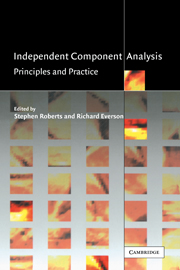Book contents
- Frontmatter
- Contents
- Preface
- Contributors
- 1 Introduction
- 2 Fast ICA by a fixed-point algorithm that maximizes non-Gaussianity
- 3 ICA, graphical models and variational methods
- 4 Nonlinear ICA
- 5 Separation of non-stationary natural signals
- 6 Separation of non-stationary sources: algorithms and performance
- 7 Blind source separation by sparse decomposition in a signal dictionary
- 8 Ensemble Learning for blind source separation
- 9 Image processing methods using ICA mixture models
- 10 Latent class and trait models for data classification and visualisation
- 11 Particle filters for non-stationary ICA
- 12 ICA: model order selection and dynamic source models
- References
- Index
Preface
Published online by Cambridge University Press: 05 July 2014
- Frontmatter
- Contents
- Preface
- Contributors
- 1 Introduction
- 2 Fast ICA by a fixed-point algorithm that maximizes non-Gaussianity
- 3 ICA, graphical models and variational methods
- 4 Nonlinear ICA
- 5 Separation of non-stationary natural signals
- 6 Separation of non-stationary sources: algorithms and performance
- 7 Blind source separation by sparse decomposition in a signal dictionary
- 8 Ensemble Learning for blind source separation
- 9 Image processing methods using ICA mixture models
- 10 Latent class and trait models for data classification and visualisation
- 11 Particle filters for non-stationary ICA
- 12 ICA: model order selection and dynamic source models
- References
- Index
Summary
In recent years there has been an explosion of interest in the application and theory of independent component analysis (ICA). This book is aimed to provide a self-contained introduction to the subject as well as offering a set of invited contributions which we see as lying at the cutting edge of ICA research.
ICA is intimately linked with the problem of blind source separation-attempting to recover a set of underlying sources when only a noisy mapping from these sources, the observations, is given-and we regard this as the canonical form of ICA. Until recently this mapping was taken to be linear (but see Chapter 4) and “traditionally” (if tradition is allowed in a field of such recent developments) noiseless with the number of observations being equal to the number of hypothesised sources. It is surprising that even the simplest of ICA models can be invaluable and offer new insights into data analysis and interpretation. This, at first sight unreasonable, claim may be supported by noting that many observations of physical systems are produced by a linear combination of underlying sources. Furthermore, in many applications, it is an end in itself to produce a set of “sources” which are statistically independent rather than just decorrelated (see Chapter 1) and for this ICA would appear an ideal tool.
- Type
- Chapter
- Information
- Independent Component AnalysisPrinciples and Practice, pp. vii - xPublisher: Cambridge University PressPrint publication year: 2001

